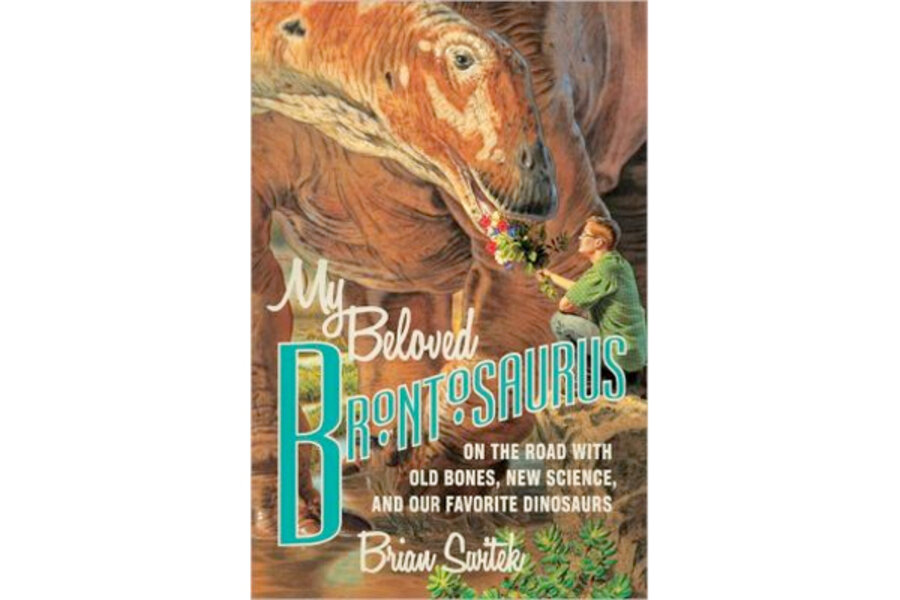My Beloved Brontosaurus
Loading...
Let's face it: dinosaurs are simply cool. We all remember learning about them with glee. When I was five, I had a friend named Raza Lawrence, and we nerded out about the big beasts together, inspecting every book, bone, and fossil we could find in Madison, Wisconsin. Although we had relatively recent tenure on the planet, our brains seemed primed to soak up any stray knowledge about prehistory: in piping voices we'd name the triceratops, brontosaurus, and tyrannosaurus. I remember that passionate love, and as a parent, I see the magic start early. Even my twenty-one-month-old can identify "dinoks." Yet despite our seemingly innate adoration of enormous extinct creatures, many of us leave dinosaurs behind right about the time we stop believing that we'll be both a policeman and a ballerina when we grow up.
Fortunately for us, Brian Switek has continued to channel the enthusiasms of his own inner five-year-old. In his zany, sometimes mind-blowing romp through the new science of old bones – fittingly called My Beloved Brontosaurus – you too can nerd out anew. It's worth it. A lot has happened since Raza and I and Switek were kids. The plodding reptilians we remember snarfing down palm leaves in hothouse conditions have been replaced by speedy, brainy – possibly even musical – beasts who'd amaze us even more now if we let them.
In fact, new science has changed the way we see old dinosaurs. Switek brings us up to speed. News flash: for those of you who weren't paying attention, "brontosaurus" is no more. The scaly, reed-eating monsters we remember loving (despite their having been dead for 150 million years) actually never existed – at least not the way we learned about them. The term arose from an early archaeological error, an amalgamation of a sleeker specimen called the apatosaurus and a diplodocus, another Jurassic herbivore famous for its long neck. And scientists are recalibrating our understanding of other species as well. What had seemed to be multiply related Triceratops species is actually only triceratops proper. It turns out that the parietal bone in the triceratops skull continues to change throughout the animal's life – making it appear radically different in its old age. Most species stop growing in adulthood, but apparently not triceratops. But that just leads to a fresh mystery: Why this late-life change? To serve what evolutionary purpose?
Other fossilized enigmas prove just as beguiling. What, for instance, was dinosaur sex like? How did giant sauropods manipulate their bulk to get, er, intimate? What were dinosaur babies like and how were they parented? What were the hallmarks of dinosaur adolescence? What can we learn from dinofuzz and dinosaur feathers? How did dinosaurs heat themselves? What can we learn from dinosaur diseases, digestion, even – ahem – dookie? In response to the last question: Quite a lot, it seems. Dinosaur dung holds trace remains of the prehistoric prairie, allowing us to reconstruct primordial ecosystems. And learning about dinosaur diseases can show us the way these seemingly invincible beings were vulnerable to parasites, germs, and their own predators.
Beware: Switek tosses around words like ossicone and deinonychsaur casually, as if you too are going to know Kentrosaurus from Amargosaurus or Oryoctodromeus from Sinornithomimous. But don't worry if you don't know your theropods from your oviraptors – even being near these words provokes a kind of glee. Meanwhile, the discoveries Switek shares fill the old world with new wonders. One species of saurian came equipped with a cranial "pan pipe" that played musical pitches through the skull – a protolanguage perhaps, a possible dino-symphony. Scientists are learning to reconstruct the actual colors of dinosaur feathers – we may find them more brightly adorned than we ever imagined. And dino-diseases can show us how the parts of the dinosaurs' world is still here, around us. Dinosaurs live on as birds, and it turns out that a parasite that killed a Cretaceous tyrannosaur is strikingly similar to one that now infects certain hawks.
In the end Switek rekindles that childhood amazement at how vast the dinosaur world really was. Each species (and there are many) represented an adaptation to its particular environment, a form evolution made possible. We're only beginning to unravel each ecological and evolutionary puzzle through the strata of soil – and our advances in technology. But we have a lot to learn from dinosaurs. After all, they were collectively around for 230 million years. They didn't die out because they weren't fit for the earth (or had altered its climate) but rather because, after a meteor crash, the earth became suddenly unfit for them. Since we've only been here for 200,000 years, and in civilized groups for 10,000, we may yet have a lot to learn from the creatures whose shadows loom over our much briefer world. Switek reminds us that we have cause for our awe.
Tess Taylor is the author of The Misremembered World, a collection of poems. Her nonfiction and poetry have appeared in the Times Literary Supplement, The New York Times, and The New Yorker.
Check out a preview of the "Brontosaurus" audiobook here:






